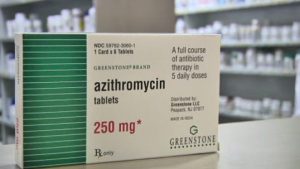How I Diagnosed and Treated My Case of B. Pertussis, aka "Whooping Cough"
TREATMENT
A Simple Antibiotic Kills Pertussis
A five day course of azithromycin is the official treatment protocol. It will kill the bacteria, and can help prevent it from spreading to others. This treatment is supposed to be given to immediate family members who have been exposed to you, too. Unfortunately, it will not help with the cough.
But it may be hard to get
Although this is a very cheap, safe, and effective protocol recommended by the government, you may find it difficult to get because doctors may not believe you have Pertussis. In my case I had to leave the hospital, go to a private urgent-care clinic, and twist their arms to get a prescription. Outside the U.S. this won’t be a problem.
This is the recommended treatment. Mine cost $1.79 with insurance. But I had to leave the hospital to get the prescription because the doctors didn’t believe I had Pertussis.[/caption]

This is the recommended treatment. Mine cost $1.79 with insurance. But I had to leave the hospital to get the prescription because the doctors still didn’t believe I had Pertussis.
Vitamin C Helps, Too
This is controversial with regular doctors but advocated by a few doctors who point to old studies from Japan and Canada showing that Vitamin C kills Pertussis bacteria in the lab and reduces the period of coughing from weeks to days. Since nobody else was offering a solution to the cough I decided to give it a shot. The protocol I followed used three different types of Vitamin C:
- Sodium ascorbate — I purchased a bottle of this vitamin C powder that claimed to be non-acidic and GMO-free. I dissolved 1,000 mg in apple juice or water and drank it three times per day.
- Liposomal vitamin C — This is a form of vitamin C that claims to be more easily absorbed by the body, and thus closer in effectiveness to intravenous vitamin C used in some studies. I dissolved 1,000mg in water and drank it once a day and during the night.
- Ascorbyl palmitate — This is a vitamin C that is supposed to be fat soluble. If true, it means you could overdose on it more easily. I only took a single 450 mg dose.
It seemed to work for me
After taking just the sodium ascorbate for 24 hours I never got another choking cough that made me feel like I was going to die. Instead I got coughs that were less violent and easier to manage. The mucous also seemed to be much thinner and easier to bring it up instead of sticking in my windpipe. Of course, a skeptic could say this was just a part of the natural improvement of the disease over time but it was a stark and substantial improvement that happened immediately and limited my coughing to just a couple of weeks. Also, I found that when the tickle in my throat would creep up, drinking some water with liposomal Vitamin C seemed to quickly tame it back down. Others have reported similar results.
Chinese Medicine
Chinese medicine has a long history of contributions to medical knowledge and correctly noted yellow tongue indicating Pertussis. They also prescribe an herbal treatment called Ban Xia Xie Xin to treat it. This treatment was studied in a paper published in Nature which claimed that it significantly reduced the presence of Bacillus bacteria in people with yellow tongue. Bacillus is a different species of bacteria than Pertussis but it is encouraging that it reduced bacteria levels.
I tried it and …
This remedy is easily available in both pill and granule form online. The traditional form is a decoction. I dissolved the grains I bought online in warm water and drank it twice per day for a week. At this point my cough was gone but my tongue was still yellow. I couldn’t tell if this treatment actually worked.
Home Remedies
Chicken soup
It is natural to eat chicken soup when you’re sick. And that ended up being all I ate for a couple of weeks. I felt like it gave me a lot of nutrition and went down smoothly without exacerbating my cough. The main ingredients were chicken, carrots, celery, onion, garlic, salt, and water.
Control your breathing
This sounds ridiculous to anyone who’s suffered the coughing fit, but it does seem to work. The trick is that when the initial burst of coughing has subsided, and you want to draw a breath, count to five. Then inhale through your nose. I preferred to take small “sips” or “sniffs” of air through my nose. Others suggest a sharp inhalation. Either way, it seems that this approach allows the Larynx to open back up so you can draw a smooth breath. This is a lot easier than trying to force air through it by gasping via your mouth.
Drink continuously
No, not that kind of drinking. Just a constant sipping of water to keep the throat moist and the mucous out. In my case I also drank lots of apple juice. And I put vitamin C in my water because it helped thin the mucous.
Sleep Upright
I just propped a couple of pillows behind my back and slept sitting up. I also bought one of those airline neck pillows to keep my head upright, although I didn’t like how it felt so didn’t use it much.
Track your oxygen levels
The first thing that happens when you go to the ER is that they take your vital signs, including your blood pressure, pulse rate, and oxygen levels. Then they assure you that your oxygen levels are fine so you aren’t going to die. I found it reassuring to track my oxygen levels both during coughing spasms, and during sleep.
I purchased a recording pulse oximeter on Amazon and it seemed to work just fine. It has an alarm that will alert you if your oxygen gets too low, and it can also track your pulse rate. The most interesting part are the reports that you can generate on your sleep the next morning. It basically showed me that aside from the coughing spells I was breathing fine, and during the coughing spells my oxygen level was not getting dangerously low for very long.
Stuff to Skip
Some of the treatments I got seemed questionable to me.
- Valium/Ativan — The idea behind Valium, or Ativan, was that it would relax the throat muscles and make the coughing less severe. It also obviously treats anxiety. There is no doubt it relaxes you a little bit, but I don’t know if that was a good thing. Specifically, I did not want to be “out of it” during a coughing spasm when I should be using my mind to control my breathing. I also did not want to get addicted to pills. And I did not want my breathing suppressed at night resulting in lower oxygen levels. So I didn’t use many of these pills.
- Inhalers — I was prescribed a couple of inhalers. One was simply albuterol, the other a “combivent” that added some other drugs. These are powerful treatments for asthma, but they didn’t do anything for my cough. In fact, when I tried to use them they actually triggered the coughing fits, because my throat was so sensitive to particulates. I quickly gave up on these.
- CPAP Machine — The CPAP machine forces air into your face creating positive pressure. It basically feels like wind blowing constantly in your face. It wasn’t bad. However, it didn’t keep me from coughing. Ultimately it got annoying so I gave up on it.
Disclaimer – I am not a doctor and this is not medical advice! But you may benefit from my experience.
